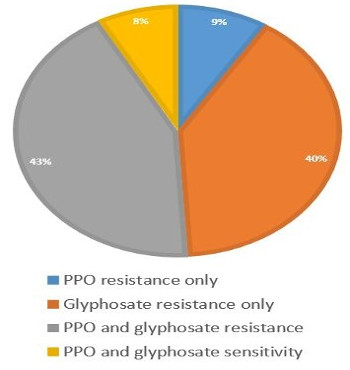In the six counties where Palmer amaranth has been detected only plants from Jackson and Redwood counties tested positive for glyphosate resistance (Group 9). None of the populations tested positive for PPO resistance (Group 14 – e.g. Flexstar and Cobra).
Tall waterhemp populations are more likely to express resistance to multiple herbicides. Figure 1 shows the results of PPO and glyphosate resistance testing for 86 plants from west central and southern Minnesota. The largest portion of tall waterhemp plants was resistant to both PPO and glyphosate herbicides (43 percent), reinforcing the idea that this is a serious and prevalent issue.
In addition, the majority of tall waterhemp populations are historically resistant to group 2 herbicides (ALS – e.g. Pursuit).

Do not let these plants go to seed
Plants can adapt quickly to herbicides
Palmer amaranth and tall waterhemp resistance to various groups of herbicides (e.g. glyphosate –group 9, Pursuit – group 2 and Flexstar – group 14) brings uncertainty about which herbicides will be most effective in any given field. Molecular tests for group 9 and 14 herbicides are readily available through the University of Illinois Plant Clinic for $50 per sample.
Pollen can transfer herbicide resistance traits
Pollen from these weeds has been shown to transfer herbicide resistant traits to nearby plants of the same species. Therefore your weed management goals should not only focus on reducing weed impact on crop yield but just as importantly, to reduce weed seed production that increases the amount of seed in the soil seed bank.
Plants produce large amounts of seed
Palmer amaranth and tall waterhemp are capable of producing hundreds of thousands of small seeds that can be easily transported via field equipment, water, wildlife and manure. Fortunately if Palmer amaranth and tall waterhemp seed production is eliminated, seed already present in the soil can be reduced to much more manageable levels in just four to five years. The bottom line is, annual herbicide costs can easily double and multiple passes through a field will be necessary once either of these weed species becomes established. Setting a goal of zero weed seed production for the next four to five years can reap long term dividends. Prevention of establishment is still the best option.
Click here to see more...